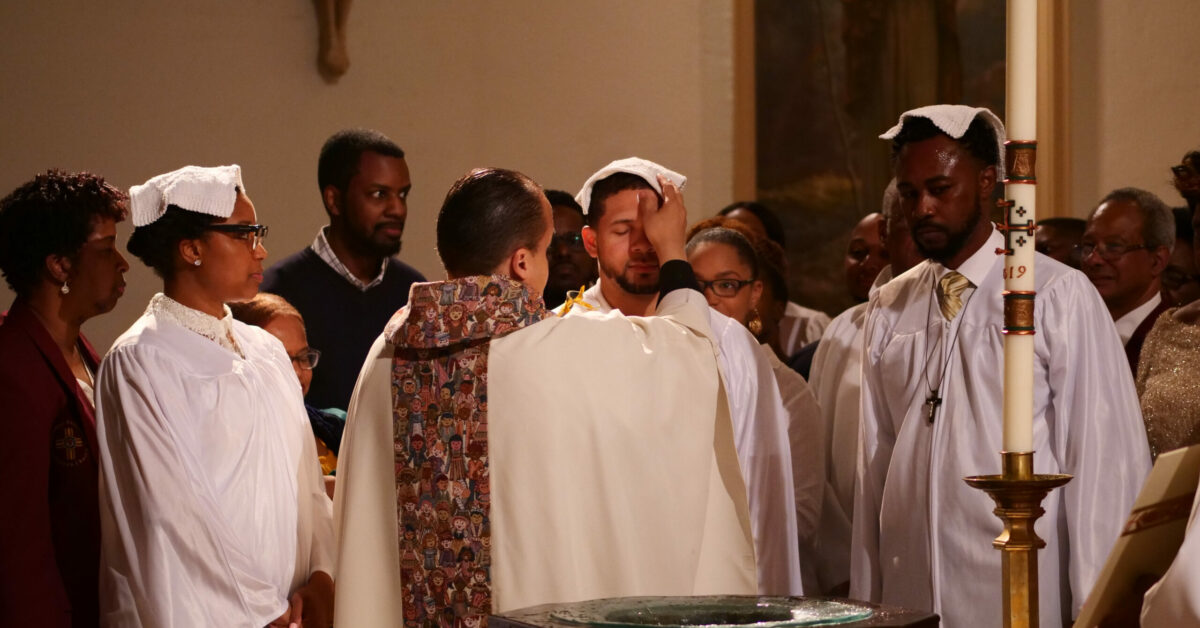Awe-Inspiring: Anointed in the Spirit
In our last post on the 4th century mystagogical catecheses I (Kent) mentioned that among the primary biblical images for baptism is the anointing of the Holy Spirit. The patterns for pre-baptismal and post-baptismal anointings vary across regions (Rome had two post-baptismal anointings, other places only one pre-baptismal anointing). All of these anointings unpacked symbolically the nature and significance of baptism, especially the bestowal of the gift of the Holy Spirit upon the baptized. Ambrose alone provides us with an abundant symbolic reflection.
According to Ambrose, in Milan the post-baptismal anointing with chrism (perfumed olive oil, often with balsam, myrrh, and other spices and oils) was no parsimonious anointing. Yarnold writes, “The chrism was not dabbed with the thumb, as it is today, but poured over the head so that it ran down like the oil which the psalmist describes running down Aaron’s beard” ([Psalm 133:2]; Yarnold, The Awe-Inspiring Rites of Initiation, 28). “Why,” Ambrose asks, “over your heads? ‘Because the faculties of the wise man are situated in his head,’ says Solomon [Ecclesiastes 2:14]. Wisdom without grace is inert, then its work begins to move toward fulfillment. This is called regeneration” (Yarnold, 120). So anointing after baptism in Milan signifies the regeneration effected by the Spirit.
Ambrose also interprets the post-baptismal anointings as messianic and priestly: “Each one is anointed for the priesthood, anointed for the Kingdom, a spiritual kingdom and a spiritual priesthood” (Yarnold, 128). Here the symbolism is oriented toward the “anointing” of the Spirit upon Christ in his baptism. The Christian participates in Christ’s anointing, an anointing for participation in Christ’s reign and in his priesthood over creation.
Yet, there is more. The anointings symbolize the gifts that the Spirit brings to the newly baptized. Ambrose:
The spiritual sealing follows….For after the ceremonies of the font, it still remains to bring the whole to perfect fulfillment. This happens when the Holy Spirit is infused at the priest’s invocation: ‘the Spirit of wisdom and understanding, the Spirit of counsel and strength, the Spirit of knowledge and piety, the Spirit of holy fear. These might be called the seven ‘virtues’ of the Spirit. It is true that all virtues belong to the Spirit; but these are, so to speak, the cardinal, the fundamental virtues….These are the seven virtues you receive when you are sealed’” (Yarnold, 124).
This reference to the gifts of the Spirit composes the text that will become what the bishop speaks in the western rite of confirmation:
Almighty God, Father of our Lord Jesus Christ, who brought these your servants to new birth by water and the Holy Spirit, freeing them from sin: send upon them, O Lord, the Holy Spirit, the Paraclete; give them the spirit of wisdom and understanding, the spirit of counsel and fortitude, the spirit of knowledge and piety; fill them with the spirit of the fear of the Lord (https://www.liturgyoffice.org.uk/Resources/Confirmation/Confirmation-Texts.shtml).
From Ambrose alone the richness of the symbolism of the post-baptismal anointings is apparent. But there is even more. As Yarnold says, “In all these rites, therefore, the purpose is to confer the Holy Spirit. But the effects of the gift of the Holy Spirit are described in many different ways: perfecting, confirming, giving divinity and spiritual perception, an anticipation of heaven, strength against the devil” (Yarnold, 38). In Baptism as symbolized by the post-baptismal anointings, the Holy Spirit is the anointing and the anointing is the gift of the Holy Spirit.
